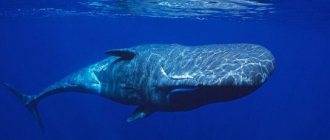Description of the gray whale
The body length of adult individuals is 12-15 m for females, and 11-14 m for males.
Weight from 15 to 35 tons. Gray whales are considered an intermediate species between the right whale and the minke whale. Their body is not as slender as the latter. The back is more convex than the belly. The head is short, compressed at the sides. There is a visible interception on the neck. The dorsal fin is absent; in its place is a small hump, behind which there are smaller tubercles on the upper edge of the caudal peduncle. The belly is smooth, there are no folds of skin on it, 2-4 furrows up to 5 cm deep and up to 2 m long run along the surface of the throat. When eating, these folds stretch to expand the mouth. The fins on the chest are short and wide. Caudal fin with a deep notch. The skull is large, the jaws are strong and heavy, of equal length, with a keel-like protrusion in front, which is necessary for “plowing” the bottom soil when searching for food. — Advertising —
The body of the animal is brownish-gray, less often black-brown. On the skin there are numerous light spots up to 10 cm in diameter, formed when ectoparasites attach to the skin. There are albino gray whales. On the head there are about 250 vibrissae, 2-3 cm long, light gray in color. The subcutaneous fat layer is well developed, reaching 30-45 cm in thickness on the chest.
Feeding characteristics of the gray whale
The gray whale feeds on about 70 species of invertebrates: polychaetes, annelids, gastropods, bivalves, small crustaceans, amphipods, sipunculids, sea cucumbers, sponges, ascidians, and small fish.
In the Bering and Chukchi Seas, its diet consists of benthic crustaceans. If there is no other food, the gray whale eats brown algae. A young whale, about 6 m long, eats approximately 116 kg of food within 12 hours, an adult (12 m long) - 552 kg. During migrations and wintering, the whale lives exclusively on the reserve of subcutaneous fat, and during this time loses a third of its weight.
What do they eat?
The diet of gray whales is varied, there are about 70 different species of invertebrate animals, including:
- bottom fish;
- small crustaceans;
- bivalves;
- annelids;
- planktonic organisms;
- amphipods;
- sipunculids;
- sponges.
An adult whale requires 500-1200 kilograms of food per day. To do this, it has to filter out tens of tons of silty soil and sand. The gray whale obtains food at shallow depths (5-100 meters). At the bottom, it lies on the side of the body and simultaneously sucks up silt, sand and prey. Then it filters food objects, swallows them, emerges to swallow air and again goes to the bottom for a portion of food.
Whales also feed on various plankton that live in the water column.
Gray whale distribution
The gray whale is distributed in the North Pacific Ocean and makes regular migrations.
Two herds are known: the Okhotsk-Korean and the Chukchi-California region. — Advertising —
The first one winters and breeds near Korea and Southern Japan; in the summer it lives in the Sea of Okhotsk, near Sakhalin. Whaling almost completely destroyed this herd. The second winters and breeds in the Gulf of California, and in the summer goes to the Chukchi, Bering and Beaufort Seas. A large herd of 26,000 individuals.
In general, the gray whale's habitat is located in subtropical, temperate and cold waters. Until the 17th century, the species was found in both the north Atlantic and the Baltic Sea, but was exterminated or became extinct.
Franz Josef Land
Best places to watch:
waters of Franz Josef Land
Types of whales:
beluga whales, narwhals, bowhead whales, minke whales.
Best season:
summer months coinciding with the period of free navigation
The waters of Franz Josef Land are another point on the map where the migration routes of different whale species simultaneously intersect. So, beluga whales traditionally come here in the summer months. In the waters of the Barents Sea you can also find the amazing “underwater unicorns” narwhals, bowhead whales, which were already mentioned earlier, and minke whales.
Franz Josef Land itself, like Wrangel Island, is notable for the pristine beauty of northern nature untouched by man, with numerous bird colonies, walrus roosts and other Red Book species of flora and fauna.
For reference. Marine animals of the Arctic - narwhal. Interesting facts about narwhals
Narwhals are one of the most amazing, rare and little-studied animals of the sea. In general, the appearance of the narwhal resembles the shape and size of its closest relative, the beluga whale. Its size is 3.5 - 4.5 meters. The difference is in the spotted color and horn.
There is a version that it was the narwhal that served as the prototype of the mythical unicorn, because its horn is exactly the same as in the well-known pictures - long and twisted around its axis in a spiral, and always to the left. In English, one of the names of this animal sounds like this - “sea unicorn”, which means “sea unicorn”. By the way, in the Middle Ages it was widely believed that absolutely all land animals had analogues in the marine environment, hence the many bizarre images of sea creatures in old manuscripts: rooster fish, dog fish, fox fish, and so on.
A narwhal's horn can reach 3 meters in length and weigh up to 10 kg. It usually appears only in males, but in some exceptional cases in females as well. In fact, the “horn” is one of the upper incisors, frolicking into the tusk in a horizontal direction. In total, the narwhal has two upper incisors, one of which is located inside the oral cavity. In the past, people attributed many mythical properties to this horn and hunted narwhals since ancient times precisely for the purpose of obtaining it.
By the way, scientists still do not have convincing hypotheses as to why narwhals need such a bulky structure. Initially, it was believed that it could be used by males as a weapon when winning their chosen one from other gentlemen, but in reality this never happens. Recent studies have shown that inside the entire bone tissue of the tusk is permeated with nerve fibers and endings, accordingly, it is logical to assume that it is used as a kind of tool for obtaining information about the outside world - for example, fluctuations and water temperature. However, in this case it is not clear why females are deprived of such a useful additional sense organ.
Narwhals are as talkative as beluga whales and can make a range of sounds from moos and clicks to creaks and roars.
Narwhals are true northerners who prefer not to leave the waters of the Arctic Ocean and stay near the edge of the Arctic ice. They are found off the coast of Canada, Greenland, as well as in the waters of Spitsbergen, the Franz Josef Land archipelago, Novaya Zemlya, and sometimes off the coast of the Murmansk region and in the White Sea.
Unlike beluga whales, narwhals, in principle, do not tolerate captivity and do not live in an artificial environment for more than 4 months. In the oceans, their average life expectancy reaches 55 years.
In the past, narwhals gathered in huge flocks of several thousand, but today they prefer to stay alone or in small groups of up to 10. Their real number is currently unknown to scientists.
For reference. Minke whale - interesting facts
The northern minke whale (razorback whale, Minke's whale or dwarf minke whale) is the smallest of all minke whales. It reaches about 10 meters in length and, like all its fellow minke whales, is recognizable by the characteristic stripes and folds that run from the underside of the animal’s body - from the head to the navel.
Currently, according to scientists, this species is not in danger of extinction. The northern population of minke whales numbers about 650 thousand. Today, this particular whale remains the main target of whaling in countries where it is still permitted - namely Iceland, Norway and Japan. It is mainly hunted by indigenous peoples according to quotas; there is also fishing for research purposes. Today, about 1,000 minke whales are caught per year.
Gray whale behavior
The gray whale makes the longest seasonal migrations of any mammal.
He swims 12,000-19,000 km per year, and in 40 years of life the distance is the same as from the Earth to the Moon and back. This is a typical coastal resident that prefers shallow waters. It can dry out without damage during low tides, and float away with high tides. The gray whale is the only whale that has mastered the bottom feeding method. It feeds at depths from 15 to 60 m, scoops up water, or pebbles and benthic organisms and filters this suspension through the whalebone. During such food production, the whale rolls onto its right side, sucks in the bottom substrate, so the whalebone wears off more strongly on the right side of the jaw, and the muzzle on this side becomes covered with scratches and wounds. If a whale plows the bottom with the keel-shaped crest of its lower jaw, it leaves “feeding holes”, up to 6 holes in one dive. To feed, gray whales often form groups of 4-6 individuals, with adults lifting the soil and young ones filtering it.
Gray whales migrate singly, in pairs or in groups of 10-18. They swim slowly, at a speed of 7-10 km/h, in case of danger up to 18 km/h. They stay under water for an average of 3-7, maximum 20 minutes. The fountain is two-jet, bifurcated, 1.5-3 m high, released at intervals of 3-20 seconds.
Gray whale breeding
The gray whale's mating season begins in December and lasts until March, peaking in January-February.
In October, the animals migrate south and in December swim to warm, shallow bays, where reproduction occurs. Pregnant females are the first to swim into the lagoons. Lonely representatives of the species stay at the mouth of the bay, females with cubs remain in shallow water, where killer whales and large sharks do not swim. Three weeks after the start of the mating season, the gray whale begins to return north. Only pregnant females and young animals stay longer than others. The duration of pregnancy is approximately one year. A calf is born with a body length of 3.6-5.5 m and a weight of 650-800 kg. Breastfeeding lasts 6-7 months, after which the baby reaches 7 m in length. All this time, females very actively protect their cubs and, in case of danger, immediately rush to their protection. The young become independent after the first migration to the north. Gray whales reach sexual maturity at the age of 8-9 years.
Population threats
Ocean pollution with oil and other toxic chemicals leads to the accumulation of harmful substances in the fatty tissue of animals and the body of pregnant females. The life and reproductive cycle of blue whales is shortened; mutations of embryos occur in the womb of females and, as a result, the birth of non-viable offspring.
The noise produced by the hydroacoustic systems of modern ships has the same frequency as the voices of whales, so communication among animals is disrupted; every year it becomes more and more difficult for them to navigate space and look for fellow tribesmen and partners for reproduction.
In areas with intense shipping, blue whales die from collisions with ships, for example, off the Canadian coast, a significant number of individuals have traces of injuries received from ships and fishing gear on their skin. In such areas, ship captains are instructed to reduce speed, but as practice shows, such recommendations are rarely followed.
Adult vomits, due to their gigantic size, are protected from attacks by sea predators, but young individuals often become prey for killer whales, which always attack in an organized flock, tear the victim into pieces and eat.
Natural enemies of the gray whale
Gray whales are parasitized by whale lice and barnacles; whales get rid of them when they rub their bodies against the bottom or swim into freshwater lagoons.
Seabirds can peck parasites from the skin of a whale that surfaces. Previously, the gray whale was an affordable and popular commercial species. But in the mid-20th century, mass hunting in California waters almost led to the extermination of the animal population. After restrictions and then a complete ban on fishing over the next half century, the number of gray whales was almost restored. Currently, gray whale fishing is permitted exclusively for the indigenous peoples of Chukotka for personal reasons.
As for the Okhotsk-Korean population, in the middle of the 20th century it also turned out to be almost completely exterminated. Today its number ranges from 125 to 150 individuals.
Interesting facts about the gray whale:
- The Red Book of Russia includes the gray whale; limited fishing is allowed only in Chukotka. Fishing is permitted using hand harpoons and motor boats. The use of firearms is prohibited. Meat and other materials obtained in this way cannot be sold.
- The gray whale became the first representative of toothless whales to enter the aquarium in the 20th century: a female 5 m long and weighing 1.5 tons was harpooned into the sea, lifted onto a ship and brought to California, San Diego, in a pool. The whale did well in captivity, but died of an infection a little over a month later.
- In the 20th century, for research purposes, scientists captured a baby gray whale, raised it for a year and then released it into the ocean, leaving a radio transmitter on the animal's back. With the help of this experiment, scientists were able to learn a lot about the life of gray whales.
Conservation status
The gray whale is listed in the Red Book of the Russian Federation, but its catch is limited in Chukotka. For mining, only hand harpoons and motor boats are allowed. Even the use of firearms is prohibited. The obtained meat, as well as other material, is prohibited from sale.
The size of the Okhotsk-Korean population at the beginning of the 20th century was 2.5-3 thousand individuals. By the middle of the 20th century it was considered completely exterminated. In 1983, 20 individuals were discovered off the coast of the island. Sakhalin, its current number is only 125-150 individuals. This population is listed as critically endangered on the International Union for Conservation of Nature (IUCN) Red List.
There is also a project to resettle some gray whales in the North Atlantic, in the Irish Sea.










